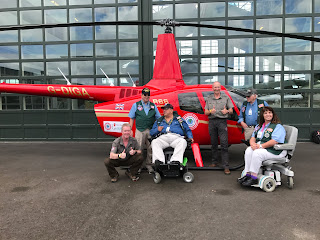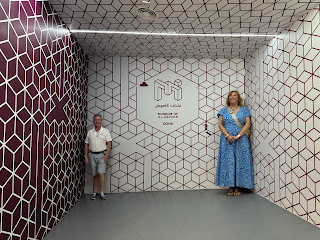McDonalds for Breakfast and Look around the Space Museum
 I am getting tired, we are over 65 days into the trip and I am beginning to feel it! Anyway I get up at 10am, dress and head to McDonalds for Breakfast before heading back to the Museum to watch a good movie about elements of a fighter pilots training. Good rabble raising stuff, the Americans are good at this stuff, I want to be a fighter pilot!
I am getting tired, we are over 65 days into the trip and I am beginning to feel it! Anyway I get up at 10am, dress and head to McDonalds for Breakfast before heading back to the Museum to watch a good movie about elements of a fighter pilots training. Good rabble raising stuff, the Americans are good at this stuff, I want to be a fighter pilot!After the film we take pictures with some of the staff before we head off and look around the Space element of the Evergreen Aviation Museum.
First envisioned by Capt. Michael King Smith, son of Evergreen International Aviation founder Delford Smith, the museum began with a small collection of vintage aircraft in a hangar at headquarters and was called the Evergreen Museum. In March 1990, the Disney Corporation, which owned the Spruce Goose, announced that it was closing its exhibit located in Long Beach, California. The Aeroclub of Southern California was notified and they immediately began the search for a new home for the Spruce Goose. In 1992, the Evergreen Museum won the bid with a proposal to build a museum around the aircraft and feature it as a central exhibit.[1]
The disassembly of the aircraft began in August 1992. The plane was disassembled and sent by ship up the Pacific Ocean, Columbia River, and Willamette River to Dayton where it was transferred to trucks and driven to Evergreen International Aviation. It arrived in February 1993.[2]
For the next eight years, the plane went through detailed restoration. Volunteers removed all the paint, replaced worn parts, and repainted the entire aircraft, among many other tasks.[3]
In September 2000, the main aircraft assemblies were complete. The fuselage, wings, and tail were transported across the highway and into the new museum building, still under construction. For the next year, crews spent their time assembling the wings and tail to the fuselage. These were completed in time for the museum's opening on June 6, 2001. The control surfaces (flaps, ailerons, rudder, and elevators) were assembled later. The last piece was put into place on December 7, 2001.
The name of the museum has evolved: Initially known as the Evergreen Museum, it changed in 1994 to the Evergreen AirVenture Museum. In 1997, the facility was renamed the Captain Michael King Smith Evergreen Aviation Educational Center in memory of Captain Smith, who died in an automobile accident in March 1995.
Work began on the space museum building in September 2006 which is identical to the aviation museum. It was completed in May 2008 and had its grand opening on June 6, 2008, exactly seven years after the aviation museum had its grand opening.[4] In 2009 the museum became an affiliate in the Smithsonian Affiliations program.[5]
A key component of the museum are the many volunteers that work there. Many are former aviators who flew the planes on display. Their detailed descriptions and real life commentary help bring the planes and their days of flight back to life.[6] The museum also offers a number of film presentations on the development and use of the aircraft, along with hands-on displays demonstrating various principles of avionics.[7]
An F-15 Eagle displayed on a pedestal in front of the EIA headquarters across the highway from the museum and a bronze statue on the pathway between the aviation and space museum are in memory of Captain Michael K. Smith.[8]
As of June 2008, two exhibit centers were open to the public: The primary structure is the aviation center with the Spruce Goose as centerpiece. The space flight center holds a Titan II missile as its centerpiece, along with the SR-71 Blackbird.[9] The Titan II sits upright in a specially constructed display extending two stories below the floor, silo fashion. The exhibit includes a re-created missile control room furnished with furniture and equipment donated from Vandenberg Air Force Base. Flight simulators for landing the space shuttle as well as for docking a Gemini capsule and performing a moon landing of the Lunar Excursion Module are visitor interactive. Attempts to obtain a retired Space Shuttle were unsuccessful.[10]
A smaller building has a seven story IMAX theater. A radio control air flight field is located behind the aviation center, near a group of Soviet built armored vehicles, including two T-34/85s, a T-55 and two armored personnel carriers.
Wings and Waves Waterpark[edit]

Exterior of the waterpark, showing the mounted Boeing 747-100
Future plans for Evergreen Aviation and Space Museum include an 84-room hotel with restaurant.
After a good look round learning good stuff about the space race, Sputnick, Mercury Missions, Gemini Missions, and Apollo etc. and listening to JFK's great speech in Houston announcing the USA's plans to be on the moon within the decade. I head of back to the hotel.
My walk takes me past some of Oregon's wineries. Oregon is trying to get in to wine in a big way.





































Comments
Post a Comment